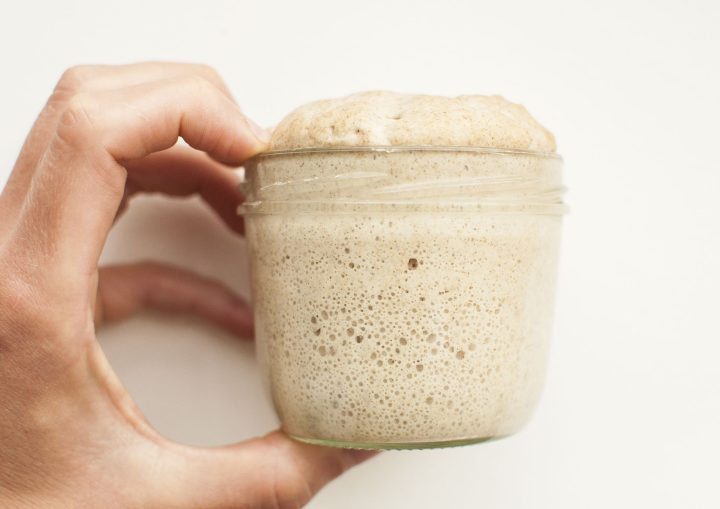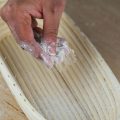When I first tried sourdough bread baking four years ago it was anything but easy. I gave up several times. Moldy sourdough starter, sourdough bricks and breads with large irregular holes and tight crumb. Not really edible and let alone great looking. Sounds familiar?
Four years later after my first sourdough bread, I can see clearly now, how easy sourdough baking can be. So today, I want to share what my biggest challenges were and how I overcame them.
1. Sourdough starter doesn’t get active or it takes too long to get active.
I used store-bought all-purpose flour to make my first sourdough starter and then I waited and I fed it and waited and fed it, etc. But nothing happened. I threw it away and started all over again – many times before it finally worked and became stable so I could use it to make a sourdough bread.
One of the reasons your starter doesn’t get active is because there is no life in the flour you are using – no wild yeasts, no bacteria, no enzymes. I advise you to use whole grain, organic, unbleached or home milled flour. I like to buy my flours at the mill so I always know I get the best quality flour and it is also a great way to support the local farmers.
For the last two years, my favorite way of starting a sourdough starter from scratch has been using a wholegrain rye flour. Rye ferments really fast, so you can have your starter ready and stable in just 3 days and there is no wasted flour due to excessive feedings. Once your rye starter is active you can always use it to make starters using other flours (white wheat starter, spelt starter). You can download step-by-step tutorial on how to make rye sourdough starter from the scratch here.

Fully active rye sourdough starter in just 3 days
2. I don’t know when my dough is ready to be put in the oven.
This one took me the longest time to figure it out. My loaves were either under-proofed (see the photo below) with tight crumb or over-proofed with no oven spring. Open crumb and nicely colored crispy crust loaves were more or less random. I was confused because the recipes I found on the internet said I should rise my bread for 2-4 hours at the room temperature or 8-14 hours in the fridge. OK, but when exactly (or near to exactly) is the the dough ready for the oven (besides seeing the difference in the volume of the bread)? Years have passed, I after many trials and errors, I find out that the poking test served me the most (besides seeing the difference in the volume of the bread). To use the poking test method, just make an indent into the dough and observe its reaction. If the indent springs back quickly, your dough is not ready yet, let it rise longer.
3. The crumb of my sourdough bread is tight or there are only small holes. I want big holes! How can I get big holes?
Factors that affect the openness of the crumb are:
– hydration level of your dough (water quantity). The lower the hydration lever, the tighter the crumb. If you are using whole grain flours which absorb more water than white flours, use more water.
– how you handle the dough after mixing,
– how strong your flour is (with low-gluten flour we usually don’t observe big crumb openness).
– how well developed and stretched your dough is (well developed dough has stronger gluten strands which can hold the bubbles or carbon dioxide better). You can develop your dough by kneading, stretching and folding, slapping and folding, long cold fermentation…), etc.
4. Sourdough bread baking takes so much time, I should be at home all the time.
I like simplicity most of the times, so being at home all day to make bread was not option for me. Well, it was in the beginning, when I was still learning and doing stretch and folds every half an hour (which I still do if I am home, just for the therapeutic purposes). There are many ways to bake sourdough bread in a way that fits our (busy) schedule without having to give up things we also like or have to do throughout the day.
And yes, it takes more time to prepare a sourdough bread than the one with commercial yeast – but here is the trick – you can do other things while the dough is fermenting. I ferment most of my breads when I am at work or sleeping and bake them when I come home or when I wake up. You can check these sourdough bread recipes: corn sourdough bread, whole grain wheat sourdough bread, rye sourdough bread with yogurt.
5. Sourdough bread will taste really sour.
This one is quite subjective and very dependable on many, many factors. I eat a lot of other fermented foods, like fermented vegetables and yogurt, so the sourness is not an issue. But hey, although it is called sourdough bread, it doesn’t have to be really sour – you can use really young starter made with white flour, you can ferment your dough for less time at the room temperature, use white flours for the dough, …
6. Sweet sourdough goods? No way!
Yes, there is a way – a highway, actually! The most simple sweet goods you can make are pancakes, waffles, or other cakes where you can easily use your excessive starter if you have any. And if you feel more olympic, you can make these fluffy chocolate sourdough doughnuts.
What was your biggest challenge with sourdough baking or issue that you would like to know more about? Let me know in a comment below.





![How To Stretch And Fold Sourdough [A Detailed Guide] 5 How to stretch and fold sourdough [a detailed guide]](https://www.mydailysourdoughbread.com/wp-content/uploads/2023/06/How-To-Stretch-And-Fold-Sourdough-120x120.jpg)